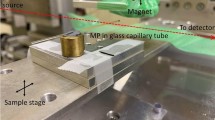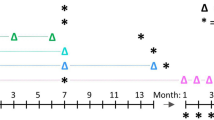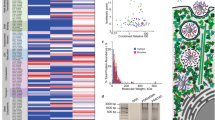Abstract
The mechanism of cell entry and intracellular fate of a gene transfer vector composed of a receptor-targeting, DNA-condensing peptide, RGD-oligolysine, a luciferase encoding plasmid DNA (pDNA) and a cationic liposome was examined. We demonstrate by confocal microscopy, electron microscopy and subcellular fractionation that the major mechanism of entry of the vector is endocytic. The vector complex rapidly (5 min) internalizes into early endosomes, then late endosomes and lysosomes. Entry involves, at least in part, clathrin-coated pit-mediated endocytosis since different conditions or drugs known to influence this pathway modify both uptake of pDNA and its expression. The observed increase in expression with addition of a lip some correlated with an increase in the rate of transfer of the pDNA to lysosomes, a decrease in intracellular recycling and exocytosis of the pDNA and an increase in the amount of pDNA in the nuclear fraction. Trafficking within the cell involved endosome fusion and the acid environment of the endosomes–lysosomes was beneficial for expression. After 30 min both the peptide and pDNA localized to the nucleus and the amount of intact pDNA in the nuclear fraction was highest with liposome and peptide. A better understanding of the cellular mechanisms by which vectors transfer to and traffic in cells should help design improved vectors.
This is a preview of subscription content, access via your institution
Access options
Subscribe to this journal
Receive 12 print issues and online access
$259.00 per year
only $21.58 per issue
Buy this article
- Purchase on Springer Link
- Instant access to full article PDF
Prices may be subject to local taxes which are calculated during checkout








Similar content being viewed by others
References
Coutelle C . Gene therapy for cystic fibrosis. Strategies, problems and perspectives. In: Strauss M, Barranger JA (eds) Concepts in Gene Therapy Walter de Gruyter & Co: Berlin, New York 1997 313–343
Lee ER et al. Detailed analysis of structures and formulations of cationic lipids for efficient gene transfer to the lung Hum Gene Ther 1996 7: 1701–1717
Lasic DD, Templeton NS . Liposomes in gene therapy Adv Drug Del Rev 1996 20: 221–266
Hart SL et al. Gene delivery and expression mediated by an integrin-binding peptide Gene Therapy 1995 2: 552–554
Zhang F et al. A transfecting peptide derived from adenovirus fiber protein Gene Therapy 1999 6: 171–181
Colin M et al. Liposomes enhance delivery and expression of an RGD-oligolysine gene transfer vector in human tracheal cells Gene Therapy 1998 5: 1488–1498
Harbottle RP et al. An Arg–Gly–Asp/oligolysine peptide: a prototype construct for integrin mediated gene delivery Hum Gene Ther 1998 9: 1037–1047
Hart SL et al. Lipid-mediated enhancement of transfection by a nonviral integrin-targeting vector Hum Gene Ther 1998 9: 575–585
Matsui H, Johnson LG, Randell SH, Boucher RC . Loss of binding and entry of liposome–DNA complexes decreases transfection efficiency in differentiated airway epithelial cells J Biol Chem 1997 272: 1117–1126
Zabner J et al. Cellular and molecular barriers to gene transfer by a cationic lipid J Biol Chem 1995 270: 18997–19007
Labat-Moleur F et al. An electron microscopy study into the mechanism of gene transfer with polyamines Gene Therapy 1996 3: 1010–1017
Zhou X, Huang L . DNA transfection mediated by cationic liposomes containing lipopolylysine: characterization and mechanism of action Biochim Biophys Acta 1994 1189: 195–203
Griffiths G, Gruenberg J . The arguments for pre-existing early and late endosomes Trends Cell Biol 1991 1: 5–9
Riezman H, Woodman PG, van Meer G, Marsh M . Molecular mechanisms of endocytosis Cell 1997 91: 731–738
Misteli T, Spector DL . The cellular organization of gene expression Curr Opin Cell Biol 1998 10: 323–331
Wickham TJ, Mathias P, Cheresh, DA, Nemerow GR . Integrins αvβ3 and αvβ5 promote adenovirus internalization but not virus attachment Cell 1993 73: 309–319
Larkin JM, Donzell WC, Anderson RGW . Potassium-dependent assembly of coated pits: new coated pits form as planar clathrin lattices J Cell Biol 1986 103: 2619–2627
Heuser JE, Anderson RGW . Hypertonic media inhibit receptor-mediated endocytosis by blocking clathrin-coated pit formation J Cell Biol 1989 108: 389–400
Li G et al. Evidence for phosphatidylinositol 3-kinase as a regulator of endocytosis via activation of Rab5 Proc Natl Acad Sci USA 1995 92: 10207–10211
Kurashima K et al. Endosomal recycling of the Na+/K+ exchanger NHE3 isoform is regulated by the phosphatidylinositol 3-kinase pathway J Biol Chem 1998 273: 20828–20836
Salisbury JL, Keller GA . Structural investigations on the role of microfilaments in ligand translocation Meth Enzymol 1983 98: 368–375
Brown EJ . Phagocytosis BioEssays 1995 17: 109–117
Leopold PL et al. Fluorescent virons: dynamic tracking of the pathway of adenoviral gene transfer vectors in living cells Hum Gene Ther 1998 9: 367–378
Nicolau C, Sene C . Liposome-mediated DNA transfer in eukaryotic cells. Dependence of the transfer efficiency upon the type of liposomes used and the host cell cycle stage Biochim Biophys Acta 1982 721: 185–190
Watanabe Y et al. Highly efficient transfection into primary cultured mouse hepatocytes by use of cation-liposomes: an application for immunization J Biochem 1994 116: 1220–1226
Memmo LM, McKeown-Longo P . The αvβ5 integrin functions as an endocytic receptor for vitronectin J Cell Sci 1998 111: 425–433
Timar J et al. Immunomorphological characterization and effects of 12-(S)-HETE on a dynamic intracellular pool of the αIIbβ3-integrin in melanoma cells J Cell Sci 1995 108: 2175–2186
Pol A, Ortega D, Enrich C . Identification and distribution of proteins in isolated endosomal fractions of rat liver: involvement in endocytosis, recycling and transcytosis Biochem J 1997 323: 435–443
Friend DS, Papahadjopoulos D, Debs RJ . Endocytosis and intracellular processing accompanying transfection mediated by cationic liposomes Biochim Biophys Acta 1996 1278: 41–50
Isberg RR, Tran Van Hhieu G . The mechanism of phagocytic uptake promoted by invasin–integrin interaction Trends Cell Biol 1995 5: 120–124
Maxfield FR . Weak bases and ionophores rapidly and reversibly raise the pH of endocytic vesicles in cultured mouse fibroblasts J Cell Biol 1982 95: 676–681
Wagner E et al. Influenza virus hemagglutinin HA-2 N-terminal fusogenic peptides augment gene transfer by transferrin–polylysine–DNA complexes: toward a synthetic virus-like gene-transfer vehicle Proc Natl Acad Sci USA 1992 89: 7934–7938
Midoux P et al. Specific gene transfer mediated by lactosylated poly-L-lysine into hepatoma cells Nucleic Acids Res 1993 21: 871–878
Erbacher P, Roche AC, Monsigny M, Midoux P . Putative role of chloroquine in gene transfer into a human hepatoma cell line by DNA/lactosylated polylysine complexes Exp Cell Res 1996 225: 186–194
Fominaya J, Uherek C, Wels W . A chimeric fusion protein containing transforming growth factor-α mediates gene transfer via binding to the EGF receptor Gene Therapy 1998 5: 521–530
Legendre J-Y, Szoka FC Jr . Delivery of plasmid DNA into mammalian cell lines using pH-sensitive liposomes: comparison with cationic liposomes Pharm Res 1992 9: 1235–1242
Farhood H, Serbina N, Huang L . The role of dioleoyl phosphatidylethanolamine in cationic liposome mediated gene transfer Biochim Biophys Acta 1995 1235: 289–295
Meunier-Durmont C et al. Mechanism of adenovirus improvement of cationic liposome-mediated gene transfer Biochem Biophys Acta 1997 1330: 8–16
Fasbender A et al. Complexes of adenovirus with polycationic polymers and cationic lipids increase the efficiency of gene transfer in vitro and in vivo J Biol Chem 1997 272: 6479–6489
Wattiaux R et al. Cationic lipids delay the transfer of plasmid DNA to lysosomes Biochem Biophys Res Commun 1996 227: 448–454
Gruenert DC et al. Characterization of human tracheal epithelial cells transformed by an origin-defective simian virus 40 Proc Natl Acad Sci USA 1998 85: 5951–5955
Wheeler VC, Coutelle C . Nondegradative in vitro labelling of plasmid DNA Anal Biochem 1994 225: 374–376
Ghosh RN, Gelman, DL, Maxfield FR . Quantification of low density lipoprotein and transferrin endocytic sorting in HEp2 cells using confocal microscopy J Cell Sci 1994 107: 2177–2189
Bradford M . A rapid and sensitive method for the quantification of microgram quantities of protein utilizing protein-dye binding Anal Biochem 1976 72: 248–254
Whitman M et al. Association of phosphatidylinositol kinase activity with polyoma middle-T competent for transformation Nature 1985 315: 239–242
Galloway CJ et al. Acidification of macrophage and fibroblast endocytic vesicles in vitro Proc Natl Acad Sci USA 1983 80: 3334–3338
Green SA, Zimmer K-P, Griffiths G, Mellman I . Kinetics of intracellular transport and sorting of lysosomal membrane and plasma membrane proteins J Cell Biol 1987 105: 1227–1240
Cesarone CF, Bolognesi C, Santi L . Improved microfluorometric DNA determination in biological material using 33258 Hoechst Anal Biochem 1979 100: 188–197
Acknowledgements
This work was supported by grants from the ‘Institut National de la Santé et de la Recherche Médicale’ (INSERM) and from the ‘Association Française de Lutte contre la Mucoviscidose’. We thank Dr E Coudrier of CNRS UMR 144 at the ‘Institut Curie’ for advice on subcellular fractionation. Our thanks to the members of the INSERM units 482 and 489 at the St-Antoine and Tenon Hospitals, respectively for access to their electron microscope. We also thank Dr M Caron, Dr E Lasnier, Ms M Auclair and Ms L Grivot of INSERM U402. CC is funded by the Muller Bequest/CF-Trust, the MRC and the March of Dimes Birth Defects Foundation. RPH and AK are supported by the March of Dimes Birth Defects Foundation (19-FY97-0632).
Author information
Authors and Affiliations
Rights and permissions
About this article
Cite this article
Colin, M., Maurice, M., Trugnan, G. et al. Cell delivery, intracellular trafficking and expression of an integrin-mediated gene transfer vector in tracheal epithelial cells. Gene Ther 7, 139–152 (2000). https://doi.org/10.1038/sj.gt.3301056
Received:
Accepted:
Published:
Issue Date:
DOI: https://doi.org/10.1038/sj.gt.3301056
Keywords
This article is cited by
-
Design of nanocarriers for efficient cellular uptake and endosomal release of small molecule and nucleic acid drugs: learning from virus
Frontiers of Chemical Science and Engineering (2014)
-
Novel Pentablock Copolymers for Selective Gene Delivery to Cancer Cells
Pharmaceutical Research (2009)
-
Intracellular Trafficking of a Fiber-modified Adenovirus Using Lipid Raft/Caveolae Endocytosis
Molecular Therapy (2007)
-
Surfactant-polymer Nanoparticles: A Novel Platform for Sustained and Enhanced Cellular Delivery of Water-soluble Molecules
Pharmaceutical Research (2007)
-
A multifunctional PEI-based cationic polyplex for enhanced systemic p53-mediated gene therapy
Gene Therapy (2006)



